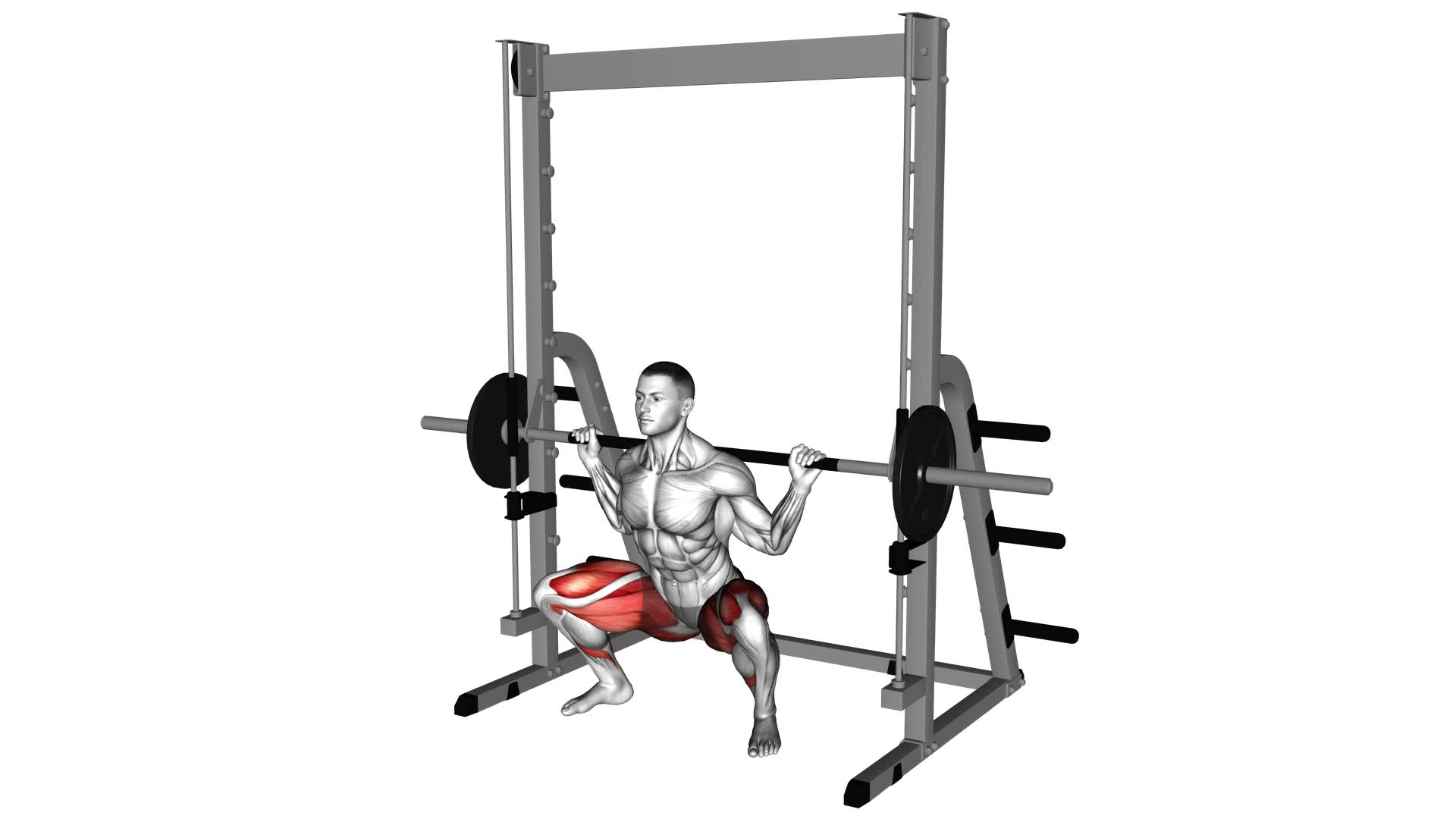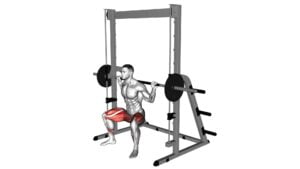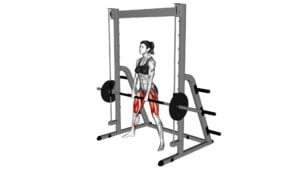Smith Sumo Squat – Video Exercise Guide & Tips

Looking to amp up your leg day routine? Check out our video exercise guide for the Smith Sumo Squat.
Watch This Exercise Video
This powerful move targets your quads, glutes, and hamstrings, helping to build strength and improve your lower body.
In this guide, we'll walk you through proper form and technique, common mistakes to avoid, and modifications for all fitness levels.
Plus, we'll share tips on how to safely incorporate the Smith Sumo Squat into your workout routine.
Let's get squatting!
Key Takeaways
- The Smith Sumo Squat targets multiple lower body muscles including quads, glutes, hamstrings, and calves.
- Proper form and technique for the Smith Sumo Squat include positioning oneself in front of the Smith Machine, gripping the barbell with an overhand grip, and keeping knees in line with toes and chest up.
- Common mistakes to avoid during the Smith Sumo Squat include allowing knees to cave inwards, rounding the back, and using excessive weight without mastering proper technique.
- Modifications and variations of the Smith Sumo Squat include adding a pulse, using a resistance band or dumbbells, varying foot placement and stance width, and incorporating tempo changes or pauses.
Benefits of the Smith Sumo Squat
What are the benefits of performing the Smith Sumo Squat?
The Smith Sumo Squat is a variation of the traditional Sumo Squat that utilizes a Smith Machine for added stability and control. This exercise primarily targets the lower body, particularly the quadriceps, hamstrings, glutes, and calves.
One of the main benefits of the Smith Sumo Squat is its ability to effectively strengthen and tone the muscles of the lower body. By incorporating this exercise into your workout routine, you can develop stronger legs, improve overall lower body strength, and enhance your athletic performance.
Additionally, the Smith Sumo Squat can also help improve core stability and balance, as it requires proper form and technique to execute correctly. This exercise can be especially beneficial for individuals who may have difficulty maintaining balance during traditional squats.
By engaging the muscles of the core and lower body, the Smith Sumo Squat can help improve overall stability and coordination.
Now, let's dive into the proper form and technique for the Smith Sumo Squat.
Proper Form and Technique for the Smith Sumo Squat
To perform the Smith Sumo Squat with proper form and technique, position yourself in front of the Smith Machine and grip the barbell with an overhand grip. This exercise is a great addition to your leg day routine, targeting your quadriceps, hamstrings, glutes, and adductors.
When performing the Smith Sumo Squat, it's important to avoid some common mistakes. Firstly, ensure that your feet are wider than shoulder-width apart and your toes are pointed slightly outward. This will help engage your inner thighs and activate your glutes effectively. Secondly, as you lower your body, focus on keeping your knees in line with your toes and your chest up. This will help maintain proper alignment and prevent any unnecessary strain on your knees. Lastly, as you rise back up, remember to squeeze your glutes at the top to maximize the benefits of the exercise.
Common Mistakes to Avoid During the Smith Sumo Squat
To avoid compromising your form and risking injury, make sure you maintain proper alignment and avoid these common mistakes during the Smith Sumo Squat.
One of the most common misconceptions is failing to keep your knees in line with your toes. It's crucial to ensure that your knees are tracking in the same direction as your toes throughout the movement. Allowing them to cave inwards can put unnecessary strain on your knees and increase the risk of injury.
Another mistake to avoid is rounding your back during the squat. It's essential to maintain a neutral spine throughout the exercise to protect your lower back. Engage your core and keep your chest lifted to maintain proper alignment.
Lastly, avoid using excessive weight, especially when starting. It's important to focus on mastering the proper technique before adding more weight. Using too much weight can lead to poor form, compromising your safety, and increasing the risk of injury.
Modifications and Variations of the Smith Sumo Squat
To further enhance your workout and target specific muscle groups, there are several modifications and variations you can incorporate into the Smith Sumo Squat. These modifications can help you challenge your body in different ways and prevent your routine from becoming stale.
One modification you can try is the Smith Sumo Squat with a Pulse. This involves performing a regular Smith Sumo Squat, but when you reach the lowest point of the squat, instead of coming back up immediately, you pulse up and down slightly before rising back up. This helps to increase the time under tension for your muscles, making the exercise more challenging.
Another variation is the Smith Sumo Squat with a Resistance Band. To do this, simply place a resistance band around your legs, just above your knees. As you perform the squat, the resistance band will provide additional resistance, targeting your glutes and outer thighs even more.
You can also try the Smith Sumo Squat with Dumbbells. Hold a pair of dumbbells in your hands as you perform the squat, which will increase the load on your lower body muscles and engage your upper body as well.
Tips for Incorporating the Smith Sumo Squat Into Your Leg Day Routine
To ensure proper form during the Smith Sumo Squat, remember to keep your feet wide apart and toes pointed outwards, while maintaining a neutral spine and engaging your core.
This exercise variation targets your quads, glutes, and inner thighs, offering a range of benefits including increased lower body strength, improved hip mobility, and enhanced stability.
Proper Form Tips
For incorporating the Smith Sumo Squat into your leg day routine, focus on maintaining proper form. Here are four tips to help you do it right:
- Keep your feet wider than shoulder-width apart and pointed outwards at a 45-degree angle. This wide stance targets your inner thighs and glutes.
- Engage your core and keep your back straight throughout the exercise. Avoid rounding or arching your back to prevent injury.
- Lower your body by bending your knees and pushing your hips back. Aim to bring your thighs parallel to the ground, ensuring your knees stay in line with your toes.
- As you rise back up, push through your heels and squeeze your glutes at the top of the movement for maximum activation.
Benefits of Variation
To maximize the effectiveness of your leg day routine, incorporate the Smith Sumo Squat for a challenging and targeted workout. Adding different squat variations to your routine helps to engage and strengthen various muscle groups.
The Smith Sumo Squat specifically targets your quadriceps, hamstrings, glutes, and adductors. This wide-stanced squat variation involves placing your feet wider than shoulder-width apart and pointing your toes outwards. By doing so, you activate your inner thighs and glutes even more.
The Smith Sumo Squat also puts less stress on your lower back compared to other squat variations, making it a safer option for those with back issues.
Incorporating this exercise into your leg day routine will provide a well-rounded lower body workout and help you achieve your fitness goals.
Safety Precautions to Consider When Performing the Smith Sumo Squat
When performing the Smith Sumo Squat, it's important to maintain proper form and technique to prevent injury. Here are some safety precautions to consider when performing this exercise:
- Adjust the Smith machine: Before starting the Smith Sumo Squat, make sure the machine is set up correctly. The bar should be positioned at a height that allows you to comfortably perform the squat without straining your back or shoulders.
- Maintain proper foot placement: Position your feet wider than shoulder-width apart with your toes pointing slightly outward. This wide stance will target your glutes and inner thighs effectively. Ensure that your knees are aligned with your toes throughout the movement to avoid placing unnecessary stress on your knees.
- Engage your core: Activating your core muscles helps stabilize your spine and prevents lower back injuries. Keep your abdominals tight throughout the exercise and avoid arching your back or rounding your shoulders.
- Use appropriate weight: Start with lighter weights and gradually increase the load as you become more comfortable with the movement. Using excessive weight can compromise your form and increase the risk of injury.
Frequently Asked Questions
Can I Do the Smith Sumo Squat if I Have Knee or Hip Pain?
If you have knee or hip pain, it's important to be cautious when doing the Smith sumo squat. This exercise puts pressure on the knees and hips, which can worsen any existing pain or discomfort.
It's recommended to modify or find alternative exercises that are less stressful on these areas. Always listen to your body and consult with a healthcare professional for personalized advice on exercises that are safe for you.
How Many Sets and Reps Should I Do for the Smith Sumo Squat?
To determine how many sets and reps you should do for the Smith sumo squat, it's important to consider your fitness goals and current level of strength. Generally, it's recommended to start with 3-4 sets of 8-12 reps.
However, if you're a beginner or have any knee or hip pain, it's advisable to consult with a fitness professional.
Can I Use Dumbbells or a Barbell Instead of the Smith Machine for This Exercise?
Yes, you can use dumbbells or a barbell instead of the Smith machine for the sumo squat.
However, using the Smith machine has its benefits. The Smith machine provides stability and helps maintain proper form throughout the exercise. It also allows you to adjust the weight easily and target specific muscle groups.
That being said, if you prefer using dumbbells or a barbell, make sure to focus on maintaining proper form and engage your muscles effectively.
What Muscles Are Targeted During the Smith Sumo Squat?
To fully understand the importance of proper form in the Smith sumo squat, it's crucial to know which muscles are targeted. This exercise primarily works your quadriceps, hamstrings, glutes, and adductor muscles.
By incorporating the Smith sumo squat into your leg day routine, you can benefit from increased strength, power, and stability in your lower body.
Can the Smith Sumo Squat Help With Improving My Vertical Jump?
Incorporating sumo squats into your workout routine can have numerous benefits, including potentially improving your vertical jump. By engaging your lower body muscles, such as the quadriceps, hamstrings, and glutes, the smith sumo squat helps to strengthen and develop power in these areas.
This increased lower body strength can contribute to better explosive power and overall athleticism, which are essential for a higher vertical jump.
To perform the smith sumo squat effectively, follow these tips…
Conclusion
In conclusion, the Smith Sumo Squat is a beneficial exercise for targeting the lower body muscles, particularly the quads, hamstrings, and glutes.
By maintaining proper form and technique, you can maximize the effectiveness of this exercise while minimizing the risk of injury. Remember to avoid common mistakes and consider modifications or variations to challenge yourself further.
Incorporating the Smith Sumo Squat into your leg day routine can help you build strength and improve overall lower body functionality.
Always prioritize safety and consult with a fitness professional if needed.

Author
Years ago, the spark of my life’s passion ignited in my mind the moment I stepped into the local gym for the first time. The inaugural bead of perspiration, the initial endeavor, the very first surge of endorphins, and a sense of pride that washed over me post-workout marked the beginning of my deep-seated interest in strength sports, fitness, and sports nutrition. This very curiosity blossomed rapidly into a profound fascination, propelling me to earn a Master’s degree in Physical Education from the Academy of Physical Education in Krakow, followed by a Sports Manager diploma from the Jagiellonian University. My journey of growth led me to gain more specialized qualifications, such as being a certified personal trainer with a focus on sports dietetics, a lifeguard, and an instructor for wellness and corrective gymnastics. Theoretical knowledge paired seamlessly with practical experience, reinforcing my belief that the transformation of individuals under my guidance was also a reflection of my personal growth. This belief holds true even today. Each day, I strive to push the boundaries and explore new realms. These realms gently elevate me to greater heights. The unique combination of passion for my field and the continuous quest for growth fuels my drive to break new ground.







